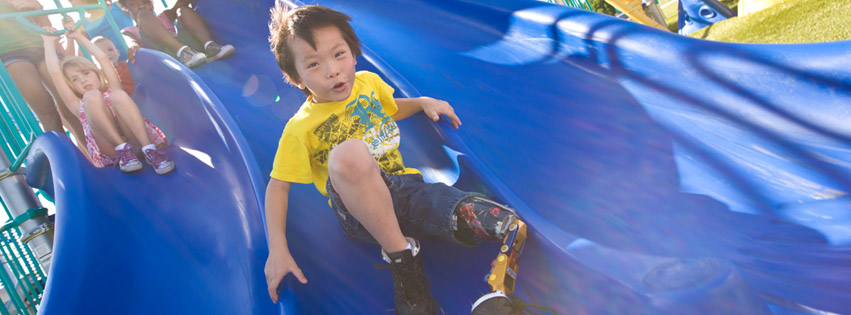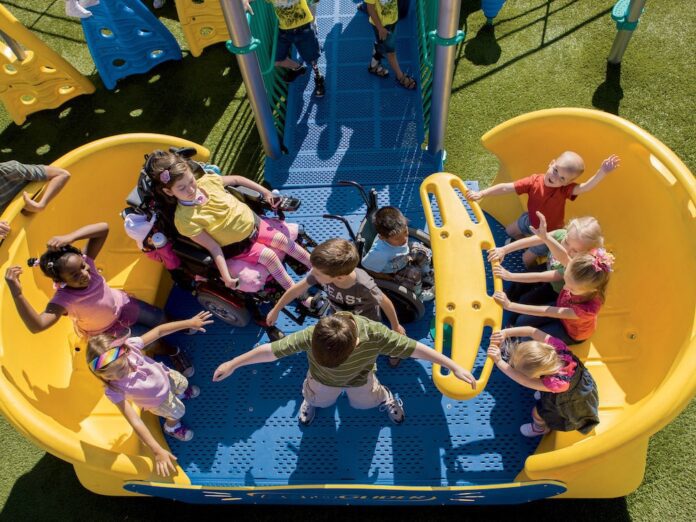Playgrounds are supposed to be a fun communal space for children of all ages to playfully explore, make friends and learn through interaction. But sometimes these public settings aren’t designed to engage people with disabilities. As a result, families can feel excluded from the ‘norms’ of life. Inclusive playgrounds, however, are helping to break isolation barriers and empower all children and their loved ones ─ with and without disabilities ─ to play together in an innovative environment. The mother of Jonathan Lopez,who has cerebral palsy, described the impact of visiting Yellowjacket Park, an inclusive playground in Texas, stating, “This playground makes me feel happy, because I have a place I can take my son where it makes us feel like a normal family.”
Based in Fort Myers, Florida, Playmore Recreational Products and Services is a park and playground equipment provider that distributes Playworld products. Fitting as playgrounds are usually a family affair, Luke Russell co-owns Playmore with his brother, Ryan Russell, and serves as Vice President of Sales. “I was roped into the playground business at an early age. My dad, Ronald Russell, used to be a consultant for the Parks and Recreation industry,” Luke shared with AmeriDisability Services. He began working with his dad as a teenager and never outgrew his love of play. Since its inception, Playmore has built ADA-compliant spaces but believed that more inclusiveness was attainable.“While the ADA rules solve some issues, like accessibility, they don’t really address inclusiveness. Inclusiveness is really the next level, and involves a lot of planning and designing to do correctly, and dollars,” Luke says. “It’s difficult to get our customers to take that next step, mainly for budget reasons.”
The root of that hesitation is, unfortunately, misconception. Luke explains that many assume that inclusive playgrounds only cater to a small percentage of people. To the contrary, according to the Kaiser Family Foundation, twelve percent of the U.S. population has a severe disability that affects at least one function of daily living. This group of people does not live in a vacuum; they have children, parents, siblings and grandparents who are involved in their daily lives. Therefore, thirty-six percent of the population, or 1-in-3 people, is touched by severe disability. “So, it’s not just about people with disabilities. It’s about including EVERYONE into play and reaping the benefits of play, whether that is physical, sensory or social. Inclusion is more than access… inclusion makes the playground fun for everyone,” Luke proclaims. Presently, Playmore has 2,000 recreational spaces in Florida alone, of which about ten are inclusive ─ a number that Luke and his team hopes to expand.

Many users attest that the investment equates to meaningful and rich experiences. “The thing I like most about the playground is being able to chase my boys all around again. Being able to go to the very top and watch them go down the slide…being able to push them on the swings, and being able to just really interact with them again,” shared Devon Colbert, a firefighter who suffered paralysis following a car accident. “The difference is really between a solid surface playground and a wood mulch playground is, being in a wheelchair, they say it might be ADA-compliant but a lot of the time you become yard art.”
Playmore works with diverse planning committees, comprised of architects, inclusion experts and others to implement eight key inclusion objectives:
1. Physical, Sensory and Social Activities: A mix of features that stimulate and affect the broad well-being of children of varying abilities.
2. Multiple Challenge Levels: Presence of graduated levels of play to engage all ages and abilities.
3. Grouping of Activities: Strategic placement of equipment to foster contiguous play and engagement among children.
4. Elevated Play: Because children generally like to experience height, inclusion of varied perception.
5. Pods, Rooms and Zones: Incorporation of specialized areas that provide both stimulation and calming security.
6. The ‘Coolest Thing’: Establishment of a signature feature that is accessible to all.
7. Unitary Surfacing: Utilization of accessible materials, such as rubber tiles versus mulch.
8. Routes and Maneuverability: Creation of double-wide ramps and other accessible pathways.
Playmore has an inclusive assessment tool that serves as a checklist to ensure ideal functionality. The company also offers a comprehensive design guide outlining essential elements to seating, restrooms, drinking fountains, shade, parking, picnic areas, trash cans, cooling devices, service animals, signage and more. Most importantly, Playmore, in conjunction with Playworld, suggests specific disability-friendly equipment that best fosters inclusive play.
Playmore is also environmental-responsible. “Through green manufacturing, we can sustain our beautiful outdoor play spaces. The physical and mental benefits of outdoor play are substantial and should be preserved for future generations,” Luke affirms. For more information, visit PlaymoreOnline.com and Playworld.com.






